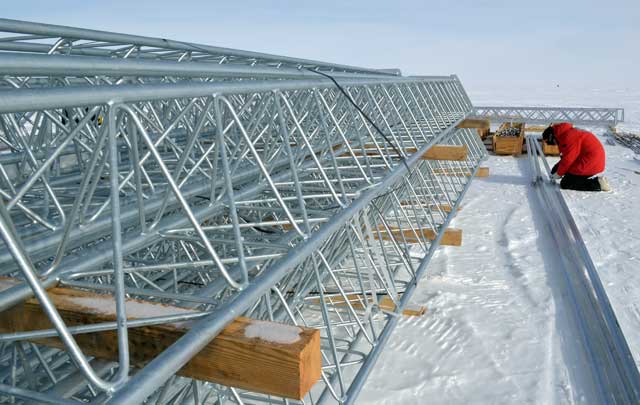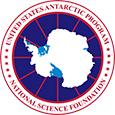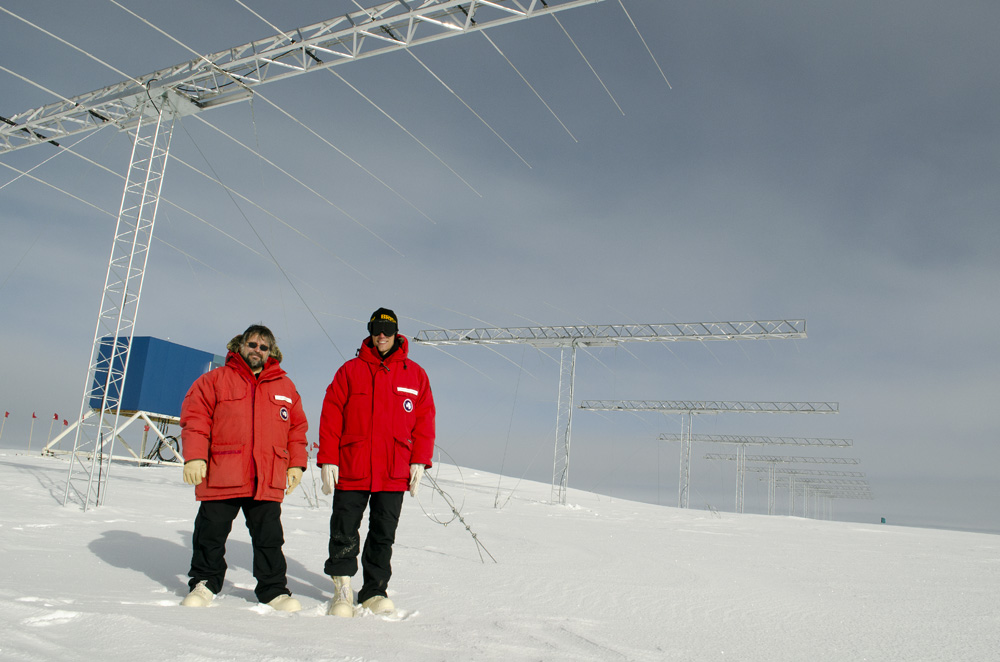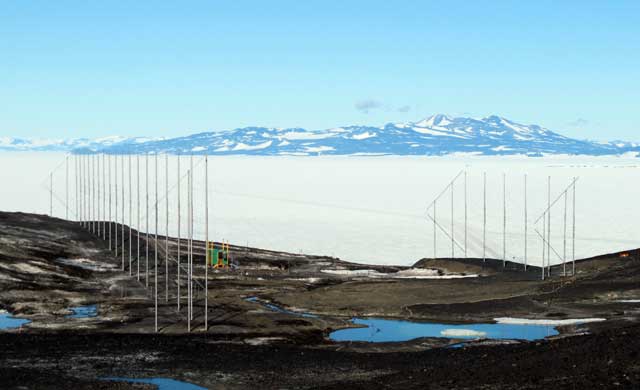Global effortSuperDARN radars in Antarctica part of network tracking space weatherPosted June 20, 2014
A small storm suddenly enveloped the South Pole Station Far, far away, hundreds of kilometers in the Earth’s upper atmosphere, a different sort of storm was also under way. The first significant solar flare of the year had reached the planet, accompanied by a coronal mass ejection – a powerful spray of solar particles. The one-year-old SuperDARN That meant a temporary HF radio blackout for communications on those frequencies – including the radar that Jef Spaleta 
Photo Credit: Peter Rejcek/Antarctic Photo Library
Scientist Alexander Morris helps assemble the SuperDARN radar at South Pole during the 2012-13 season.
“There’s a lot of dynamic activity in the Earth-sun interactions. All of that energy input is right in the upper atmosphere,” Spaleta explains while taking a break from the storm closer to home in the station’s cafeteria. “If you want to understand the impact of the sun’s variations in its output – either its solar output or particle output – you have to look [in the upper atmosphere].” The South Pole radar is one of about three dozen antenna arrays around the world that now make up the Super Dual Auroral Radar Network – SuperDARN. Spaleta is a post-doctoral fellow at the University of Alaska at Fairbanks (UAF) SuperDARN is an international effort, with the U.S. sites funded by the National Science Foundation (NSF) The SuperDARN project’s ultimate goal is to produce a unified space weather model, which, based on conditions at the sun, can predict what will happen in the Earth’s atmosphere. Starting at about 85 kilometers above the Earth’s surface is the ionosphere, an electrically charged layer of the upper atmosphere where ionized gas forms plasma with conductive properties similar to metal. Solar wind particles from coronal mass ejections hit the planet’s magnetic field, which focuses them toward the poles where they collide with atmospheric particles, creating the spectacular light effects of the Northern Lights (aurora borealis) and Southern Lights (aurora australis). While such visual effects may be stunning to watch, such near-Earth atmospheric disturbances from the sun – one sort of space weather – can wreak havoc on electrical grids. Meanwhile, radiation from solar flares can affect humans in space or in high altitudes aboard airplanes, as well as disrupt unshielded electronics in satellites. Space weather is also related to weather in the troposphere – the layer of atmosphere closest to the planet that affects life on Earth – in ways scientists are still trying to understand. SuperDARN has been described as working like a police radar gun, which sends out a burst of radio waves at a certain frequency. The waves strike the vehicle and bounce back toward the radar gun, which measures the frequency of the returning waves, a process known as the Doppler Effect. The faster the car’s speed, the higher the frequency of the returning wave. In the case of the SuperDARN radar, it is measuring the plasma circulation in the ionosphere using the Doppler Effect. The electromagnetic forces that create the plasma circulation in the ionosphere can be represented by a voltage pattern. Space weather is driven by high and low voltage systems similar to how atmospheric weather is driven by high and low pressure systems. SuperDARN is reportedly the only system capable of producing such voltage maps at 300 kilometers altitude. The current network is capable of covering half of the Earth’s surface of every minute of every day. “You can do it with satellites, but you don’t get the continuous coverage,” notes Spaleta, who with graduate student Alexander Morris, also from UAF, spent several weeks on the Ice doing maintenance on the South Pole and McMurdo radars. The latter experienced a structural failure when heavy frost on the Kevlar line that connects the poles of the radar array snapped, causing one of the antennas to fall. “It looks far worse than it actually is,” Spaleta says. Repairs are planned for the 2014-15 field season. The first SuperDARN-type radar was constructed in Labrador in northern Canada in 1983 by JHU/APL. The second radar was constructed at Halley Station The success of the first pair of radars led to the formulation of the SuperDARN concept in 1992. Since then, the network has grown rapidly in the last two decades. Spaleta has been involved in about a half-dozen installations in the last five years himself. “One radar is interesting, but the network of radars is what’s really interesting,” he explains. “The idea is that we want to look at long timescales – solar cycle scales – and get an overall climatological look at the upper atmosphere.” NSF-funded research in this article: William Bristow, University of Alaska at Fairbanks, Award Nos.0337635 and 0944270 |



For USAP Participants |
For The Public |
For Researchers and EducatorsContact UsU.S. National Science FoundationOffice of Polar Programs Geosciences Directorate 2415 Eisenhower Avenue, Suite W7100 Alexandria, VA 22314 Sign up for the NSF Office of Polar Programs newsletter and events. Feedback Form |




